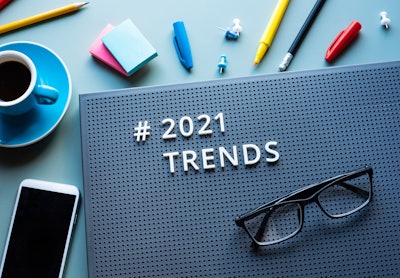
Sure, we’re all eager to get back to in-person gatherings—but until then, it can be a challenge to see the best path forward. The good news? A number of insightful industry surveys have recently come out that can shed some light on what works best for virtual gatherings, when attendees will feel safe traveling, the impact of the COVID-19 vaccine and more.
We scoured the surveys to find the most important findings you should keep in mind this year.
1. 80% of virtual events are free.
That’s according to a study from event software platform Bizzabo, which analyzed almost 2,000 virtual events that took place between July 1 and Oct. 31, 2020, and also polled 400 event marketers.
As the industry adjusts to the new virtual world, many planners seem to have prioritized greater audience reach over ticket costs—particularly for association-related events. In fact, a recent white paper produced by the London-based Institute of Association Leadership found that "some organizations have been seemingly apologetic for the move to digital, charging nothing for their content," leading to financial struggles. (Associations on average lost 30% of their revenue in 2020, according to the institute’s research.)
The key to combating that? Recognizing that digital content and engagement opportunities can be just as impactful as in-person experiences—and that by charging a fee, your attendees may actually be more engaged and invested. The Event Service Professionals Association, for example, charged its standard ticket prices for its virtual conference last month and found that members were still willing to pay—especially since the costs of transportation and lodging were nonexistent. (The association also offered discounted tickets to members who were experiencing financial hardships due to the pandemic; click here to read more about the conference.)
For event hosts who are charging, though, Bizzabo notes pricing is going up, possibly as attendees recognize the value they can get from the experience. The average price for a paid virtual event in the last six months of 2020 was $443, says the study, compared to $378 earlier in the year.
2. Networking and engagement remain the biggest challenges of virtual events.
A recent study from event company Global DMC Partners, which in December surveyed 242 meeting- and event-industry professionals from all around the world, found that 63 percent of respondents say audience engagement is their top concern surrounding virtual events, followed by budgets. The Bizzabo study had similar results: 68.8% of survey respondents said it was difficult to provide helpful networking opportunities to virtual attendees, and 67.7% said keeping attendees engaged was a challenge.
So what does this tell us? Interaction is everything. Bizzabo says that over half of the virtual events it studied capped live attendance at 300, giving attendees the chance to go “onstage” and participate. (Larger, broadcast-style sessions and keynotes only accounted for 16% of events.) Give attendees a chance to interact with live Q&As, polling, breakout rooms and more. “There are multiple ways to facilitate connection at your virtual event, like setting up roundtable discussions based on similar interests or creating Slack groups where attendees can network with their industry peers,” suggests the Bizzabo study.
3. Most organizers are enabling on-demand content for virtual sessions.
With more at-home distractions than ever, it can be hard to get virtual attendees to actually show up on event day. (In fact, Bizzabo found that only about 50% of registrants actually attend a virtual event.) Keeping that in mind, Bizzabo found that 80% of event planners are enabling on-demand access for at least one of their sessions. Making content available after the event is a great way to reach a larger audience—particularly those in different time zones—and to keep content evergreen and useful year-round.
It’s a strategy Facebook used for its annual conference for global marketing and sales staff, which shifted online last March. Education sessions were released as a series, allowing employees to watch as soon as an episode was available or later on-demand. “The content continues to be available and is encouraged viewing as part of onboarding for new members within the organization—something that we have learned is a great benefit of having a virtual event,” explained Vince Belizario, senior vice president and group account director for event producers Jack Morton, in an interview this summer.
4. For associations in particular, virtual may be here to stay.
Software company Personify—which polled nearly 1,000 association members and staff in December—showed that virtual is key. More than half of the associations surveyed had hosted a virtual event in 2020, and the majority reported that it was "very valuable" or "somewhat valuable" for meeting members' needs. On the flip side, 44% of association members said they'd found "meaningful connections" at a virtual event in 2020.
When asked what types of meeting formats they would prefer if all COVID-19 restrictions were lifted, a third of respondents voted for in-person and another third likes hybrid—but the last third actually prefers the virtual approach. The takeaway here? Many association members are focused primarily on learning new skills and acquiring certifications (which 46% of respondents said was the most important reason for their memberships), and that’s something that can be done virtually. Just don’t forget to add a networking option: More than half of Personify’s survey-takers said digital networking and an online community for members are important to them.
5. Most respondents won’t feel comfortable attending large events until late 2021—at the earliest.
While nobody has a crystal ball, several of the surveys predicted that in-person meetings would really pick up steam later this year. In the Global DMC Partners study, for example, 53% of planners think that their in-person meetings will resume in Q3 or Q4 of 2021. (Those respondents cited general health and well-being of attendees' family and friends as the top concern, rather than travel restrictions or job security.) Respondents also predicted that the largest in-person events in 2021 would be capped at 250 attendees, and that most will incorporate a hybrid or virtual component to bring in more people.
Similarly, a recent survey from Innovatis Group, a Nashville-based association management company, asked more than 1,000 professionals who frequently attend events to give their opinions on in-person events and travel in 2021. The result? Just over half of respondents said that the size of an event would impact their decision to attend, even if all the appropriate safety precautions were taken. Most said they’d only attend events of under 50 people, for example, and that may drop even lower depending on local regulations. This may show that smaller, local events—along with virtual components—are the right call for the foreseeable future; last month’s Event Service Professionals Association virtual conference, for example, featured small, socially distanced networking events in cities with fewer gathering restrictions.
6. Work-related travel restrictions may continue to be a factor this year.
While Innovatis Group found that 81% of respondents will be ready to get on a plane in late 2021, they also found that many companies are still hesitant to allow work-related travel. In fact, more than 49% of companies surveyed have an all-out ban on travel, while 47% have cut, frozen or reduced travel budgets for 2021.
However, Global DMC Partners did find that more U.S.-based companies were allowing their employees to travel than non-U.S.-based companies, which are reportedly being more conservative.
7. Vaccines are the key to in-person gatherings.
No surprises here. In the Global DMC Partners study, a whopping 92% of respondents said that a vaccine is the most important factor in bringing back face-to-face events. Innovatis Group’s respondents agreed, saying that 58% of them would consider attending in-person events sooner if vaccines were widely available. (Related: 70% would return sooner if COVID-19 cases dropped significantly.)
The lesson here? “No matter how important it is to the bottom line, it’s important not to frantically jump straight back to large, in-person events,” writes the Innovatis team. “Instead, be strategic about slowly introducing in-person, small events with proper safety precautions. Even with vaccine availability, people will want to see health safeguards in place.”
This story originally appeared on BizBash's parent site, ConnectMeetings.com, here.



















